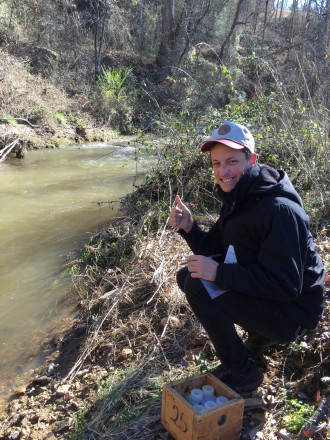To the humans of Western North Carolina, flooding is a state of emergency. As the remnants of subtropical storm Alberto put the finishing touches on 14.68 inches of rain for the month of May in Asheville — an all-time high, besting the National Weather Service’s previous monthly record for the city of 13.75 inches in August 1940 — shopkeepers in Biltmore Village scrambled to sandbag their buildings. Black Mountain residents dealt with busted water lines, while nearly 2,000 residents of McDowell County were ordered to evacuate over fears the Lake Tahoma dam could fail.
To the region itself, however, the recent rains are just another drop in the bucket. “The first thing to keep in mind is that floods occur naturally. Our waterways have been in similar conditions for the last 15,000 years or so,” says David Gillette, associate professor of environmental studies at UNC Asheville. “It’s just like a forest fire: A flood seems catastrophic looking at it from our perspective, but it’s something that happens often enough that, to be able to survive, species have become adapted to it.”
While the flood’s immediate aftermath may negatively impact water quality and populations of aquatic life, research suggests that WNC’s watersheds readily recover from similar events over the long term. But Gillette and other area experts emphasize that humans do play a role in maintaining the resilience of the region’s streams, rivers and lakes as development continues along their banks.
Ebb and flow
Ann Marie Traylor, executive director of the Black Mountain-based nonprofit Environmental Quality Institute, draws her confidence in the region’s recovery from a study her organization conducted after Hurricanes Frances and Ivan hit WNC in September 2004. Using monthly water samples from over 200 sites taken both before and after the hurricanes, EQI was able to analyze how water quality changed as a result of the storms.
For nearly all of the sampled locations, the answer was not much. “Generally in 2005, sites that had previously earned excellent water quality ratings still were excellent and sites that had earned poor ratings remained poor,” Traylor says. Each of the eight variables EQI measured, including pH, turbidity and lead concentration, largely returned to their baseline values after the floodwaters receded.

Although last month’s rains exceeded the total for the 2004 storms (12.96 inches), Traylor estimates that watersheds will respond in much the same way. “There’s a lot of sediment on the dry ground from where the floodwaters have receded, and I expect the next couple of big rains we get to flush that back into the streams and lakes,” she says. “But based on what we’ve seen in the past, I would say that water quality will be about back to normal within the coming year.”
EQI does not directly test for toxins, such as oils and heavy metals, which may wash into waterways from road runoff and flooding. However, the organization does sample populations of aquatic invertebrates in partnership with the Pigeon River Fund, which Traylor says provide a useful indicator of overall water quality. “Looking at the invertebrates can tell you if something is going on in the stream beyond just the nutrients and sediment that you’re able to look at directly,” she explains.
The post-hurricane study found some declines in these populations, but those changes mostly took place in areas with existing water quality problems. EQI thus attributed the decreases to habitat disruption directly associated with the flood, and subsequent monitoring shows that numbers have recovered as conditions return to normal. “We found that very high stream flows did not have a significant negative effect on the long-term health of aquatic organisms and that their health has been improving over the course of the study,” confirms UNCA professor of mathematics and study co-author Steve Patch.
Life aquatic
Gillette, who was not involved in the EQI study, says those findings agree with ecology’s general understanding of waterways. “[Flooding] might decrease population size a bit, but most of the species that live in these rivers have the ability to repopulate pretty quickly,” he says. “Insects, which are a lot of the invertebrates, may only have life cycles on the order of one year; within a year, maybe two at most, you’d expect things to be right back where they were.”
The biggest danger flooding poses to aquatic organisms, Gillette points out, is high erosion from watersheds that have been disturbed by human activity. Forested areas can hold vast quantities of rainfall without washing away, but the looser soils of urban or agricultural landscapes are often carried off into nearby bodies of water.
That sediment increases the water’s turbidity, in some cases beyond the ability of resident species to tolerate. Gillette says that freshwater mussels, already a threatened group of species, are especially at risk. “They rely on filtering particles out of water to get their food, so these high levels of particulate matter can literally clog up their siphons,” he explains.
Fish can also be threatened by large amounts of sediment. Gillette has seen many species that thrive in clean water, such as trout, die from clogged gills after soil washed into their streams. Other species, such as minnows and darters, hunt by sight and can go hungry when turbid water prevents them from finding their prey.
These species have evolved to deal with occasional disruptions in water quality, but Gillette worries that human development could interact with floods to cause problems that exceed the animals’ ability to adapt. “We have a lot more erosion than we would have before these areas were built up,” he says. “That would be a disturbance that’s different from what would normally occur over evolutionary time.”
Mother Nature’s helpers
Even with current development, however, Gillette thinks WNC’s waterways will continue to bounce back from extreme weather events. “But they’ll be more resilient if we can practice a couple of common-sense management practices,” he adds.
The most important of these practices, Gillette says, is for property managers to maintain undisturbed, vegetated buffer zones along the edges of waterways. Plants slow the movement of precipitation, hold soil together with their roots and take up nutrients that would otherwise wind up in the water. He also recommends rainwater capture systems such as rain barrels and rain gardens.
Traylor agrees, mentioning EQI’s network of partners that work to prevent erosion along the region’s banks. “They’re the ones with boots on the ground, actually putting in best management practices and trying to make events like this less catastrophic,” she says. “When there’s more of a riparian zone, there’s less ability for streams to be eroded when we get a lot of rainfall.”
Some area organizations are hoping that federal funds could provide help for flooding recovery and future mitigation efforts. Gary Higgins, director of the Buncombe County Soil and Water Conservation District, says his department is waiting to hear about monetary assistance for landowners, while Clint Calhoun, environmental management officer for the town of Lake Lure, says the state of emergency in Rutherford County declared by Gov. Roy Cooper may bring money from the Federal Emergency Management Agency. For the moment, however, Calhoun and his crew are clearing flotsam from the lake and mapping sediment deposits to to quantify the scope of the problem.
“We’re taking it one day at a time; it’s really all we can do right now, given the staff that we have and the amount of debris that we’ve had put into the lake,” Calhoun says. “We’re just trying to do the best we can and prepare for the next one. There’ll be more!”






Before you comment
The comments section is here to provide a platform for civil dialogue on the issues we face together as a local community. Xpress is committed to offering this platform for all voices, but when the tone of the discussion gets nasty or strays off topic, we believe many people choose not to participate. Xpress editors are determined to moderate comments to ensure a constructive interchange is maintained. All comments judged not to be in keeping with the spirit of civil discourse will be removed and repeat violators will be banned. See here for our terms of service. Thank you for being part of this effort to promote respectful discussion.